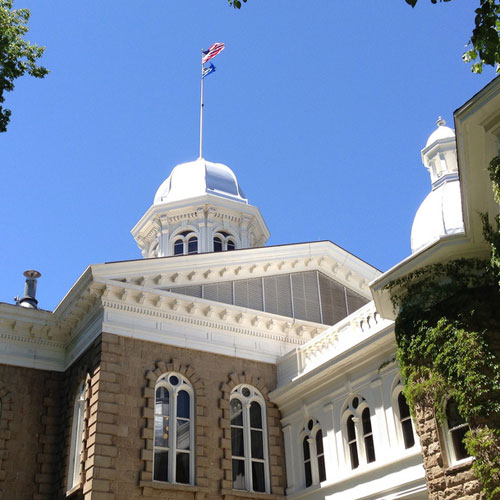The truth about the coming state budget: Reports of a surplus have been greatly exaggerated

"We’ve got a plan to increase education funding by half a billion dollars…”
—Republican gubernatorial contender Adam Laxalt in a news release, 8/28/18
"Everything is on the table except for one thing and that’s doing nothing and the status quo, because it’s not working,”
—Democratic gubernatorial candidate Steve Sisolak, 3/6/18
So one candidate thinks he can increase education spending by $500 million without raising taxes and the other wants to put more money into the K-12 budget but is vague as to just how much.
No wonder Gov. Brian Sandoval’s hair appears grayer these days.
With early voting only five weeks away, I decided to clarify some of the numbers for voters who wonder what’s real. So I talked to Mike Willden, the governor’s inestimable chief of staff who has been in state government 45 years and whose knowledge of the state budget exceeds anyone there now.
Here are some facts to consider as you listen to the gubernatorial candidates talk about what a recent Reno Gazette-Journal poll showed is the most important issue in the contest:
---The current biennial budget is $8.1 billion. The next biennium’s budget baseline will be set by the Economic Forum in December. Willden told me that many economists are privately saying the number is going to be about $8.5 billion, perhaps a little higher. So we can expect perhaps $400 million or $500 million in new revenue. This approximation is likely where Laxalt’s number comes from – and it is very misleading on its face. Why? Read on.
---Anyone who has been a watcher or planner of the state budget for any length of time knows there is almost always a lot of new money – except, of course, during recessions. They also know those new dollars are mostly gobbled up by three inexorable factors: base adjustments because the previous budget was increased; rollup costs because of increasing caseloads, especially in K-12 and Medicaid; and inflation.
That trifecta of increases is almost always hundreds of millions of dollars, Willden reminded me. “They’ll eat up a big piece of new revenue,” he said. “They will eat up a majority of new money.”
And in 2019, there will be other factors draining the surplus, too, Willden added.
The Federal Medical Assistance Percentages (FMAP) – the federal matching funds for health care under the Affordable Care Act – begin to decrease after a 100 percent match in previous years. And a 98 percent federal reimbursement rate for Nevada CheckUp, a state program for children, drops to 75 percent.
“The state will have to put more money in,” Willden said.
The bottom line: “There will not be a huge increase (in available revenue),” Willden said, citing his 30 years of experience with building budgets.
---There are “revenue unknowns,” too, Willden told me. There is $221 million in the Rainy Day Fund, some of which was poured in there because of an aborted attempt by state Senate Republicans in 2017 to hold up the session over ESAs, which prevented some of the pot money from going to education. Most everyone agrees that the marijuana excise tax money should be put into education, which would remove $50 million from the reserve fund, which has been notoriously lean.
Some of the tax credits that were awarded to Tesla also are going away, too, which could have a positive impact on the budget, Willden said.
---The Commerce Tax, which Laxalt wants to repeal and presumably would strike from his budget, brings in about $200 million a year. Because the companies making more than $4 million in a year can deduct their payroll taxes, the net to the state is about $150 million a year, or $300 million for the biennium.
Despite Laxalt’s insistence that it is a small part of the budget – he has given several different numbers from less than 1 percent to 2 percent – it is the fifth largest source of revenue for the state, Willden said. The top five: Sales tax, gaming taxes, payroll tax (Modified Business Tax), insurance premium tax and the Commerce Tax.
A Gov. Laxalt would have to find $300 million if he struck the Commerce Tax. From where?
---All in all, the state may find itself with as much as a half a billion in new dollars but will not have much if any excess for new spending. As Willden put it, there will be money for enhancements, but not much.
So Laxalt’s “plan” for $500 million for additional education spending is sheer fantasy. And if he succeeds in scuttling the Commerce Tax and subtracts $300 million, he will put the state in the red. If he isn’t going to cut education, what exactly is he going to cut?
As for Sisolak, his website says he wants to increase teacher salaries and reduce class sizes as well as fix an antiquated formula for funding lower education, even though there will be little to no new money to cover any of that. That’s quite a feat, too, then, without cutting something deeply or raising taxes.
It’s time, with such a short interval until the election, that both contenders explain what they will do — and how.
Update on 9/14/18 at 9:55 a.m.: A couple of hours after this piece was published, the Adam Laxalt campaign went up on TV with an ad boasting that if elected, he will add $500 million to the state's education spending.
